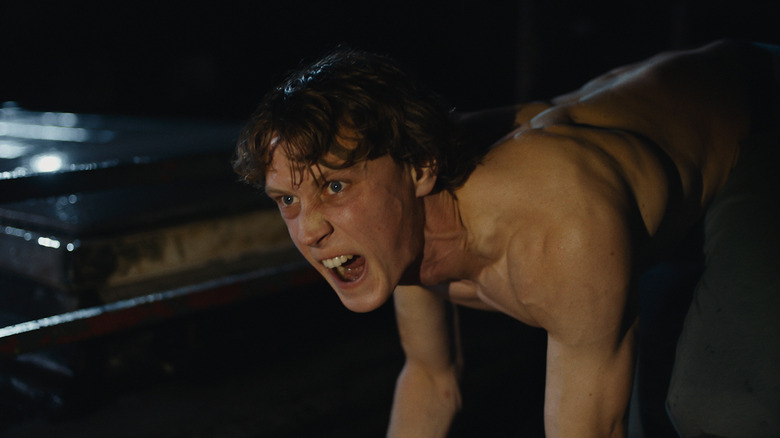Wolf Star George MacKay Reveals His Secret Behind Playing A Man Who Thinks He's An Animal - Exclusive
British actor George MacKay has played a Lost Boy in 2003's "Peter Pan" (his screen debut), a young Jewish freedom fighter in 2008's "Defiance," a traumatized young man in a war-torn future in 2013's "How I Live Now" and a soldier in the 2019 World War I film "1917," among many other roles. But one thing he's never played until now is an animal — or at least, a human being who thinks he's an animal.
MacKay stars in the film "Wolf," in which he plays a young man named Jacob who believes that he is a wolf and wants to live in the wild. His parent enter him into a facility that deals with species dysphoria — the medical term for his "condition" — where he falls in love with a fellow patient named Wildcat (Lily-Rose Depp). He also matches wits with the center's sadistic chief, Dr. Mann (Paddy Considine), who wants to "cure" him even though Jacob does not wish to deny his true nature.
MacKay says he "hadn't heard anything about" species dysphoria before taking the role, adding that he didn't do much research into the condition because Jacob doesn't actually think that he has it — he's just fully committed to the idea that he's a wolf. So how did he prepare to take on the part? "I kind of went down the wolf side of things a lot more and then thought it will be his context that tells him what he's got," MacKay tells Looper.
George MacKay explored the psychology of being a wolf
After accepting the role in "Wolf," George MacKay decided that Jacob really does believe he is a "wolf in a man's body." That led to a new range of questions for MacKay: "The joy of the role is trying to figure out the amalgamation of living with animal instincts. Like how does he see the world?"
MacKay's goal was to be as true as possible to wolf nature, explaining, "All of the research on wolves is a human interpretation of one, but there was some amazing stuff about the way that wolves operate or are perceived to operate on a more scientific level that I thought was interesting for the character, and tied that to the journey that he's on."
To get the physicality of a human who carries himself like a wolf, MacKay turned to motion capture expert Terry Notary. "Working with Terry was amazing," MacKay enthuses. "One of the biggest things that we worked on, before the aesthetics of the crawling and the kind of more obvious physical work in that sense was, what is it to be wild? What is it not to be human?"
Another important aspect of playing a wolf for MacKay was learning how to howl and getting it the way he wanted it to sound. "It was a mixture of going, 'All right well, he's a wolf. He's howling. What is a howl to a wolf?'" he says. "So I went through some more scientific research and looking at wolves and books and studies on wolves, which again is a human interpretation as to why howls are used and what we think that they're saying."
The end result? A performance that may end up being one of the strangest and most compelling of this year, all without the assistance of visual effects or furry makeup.
"Wolf" is now playing in theaters.

